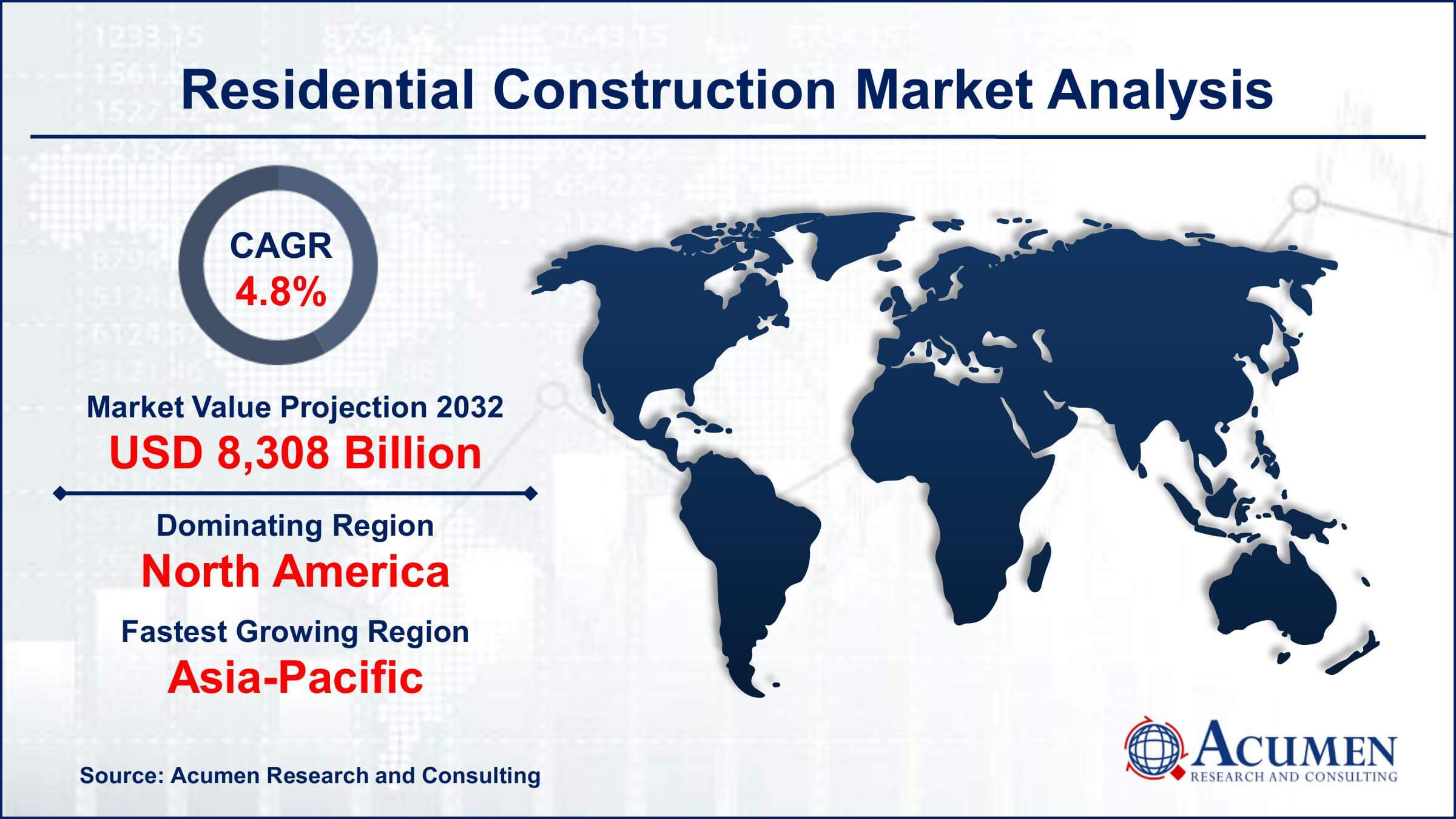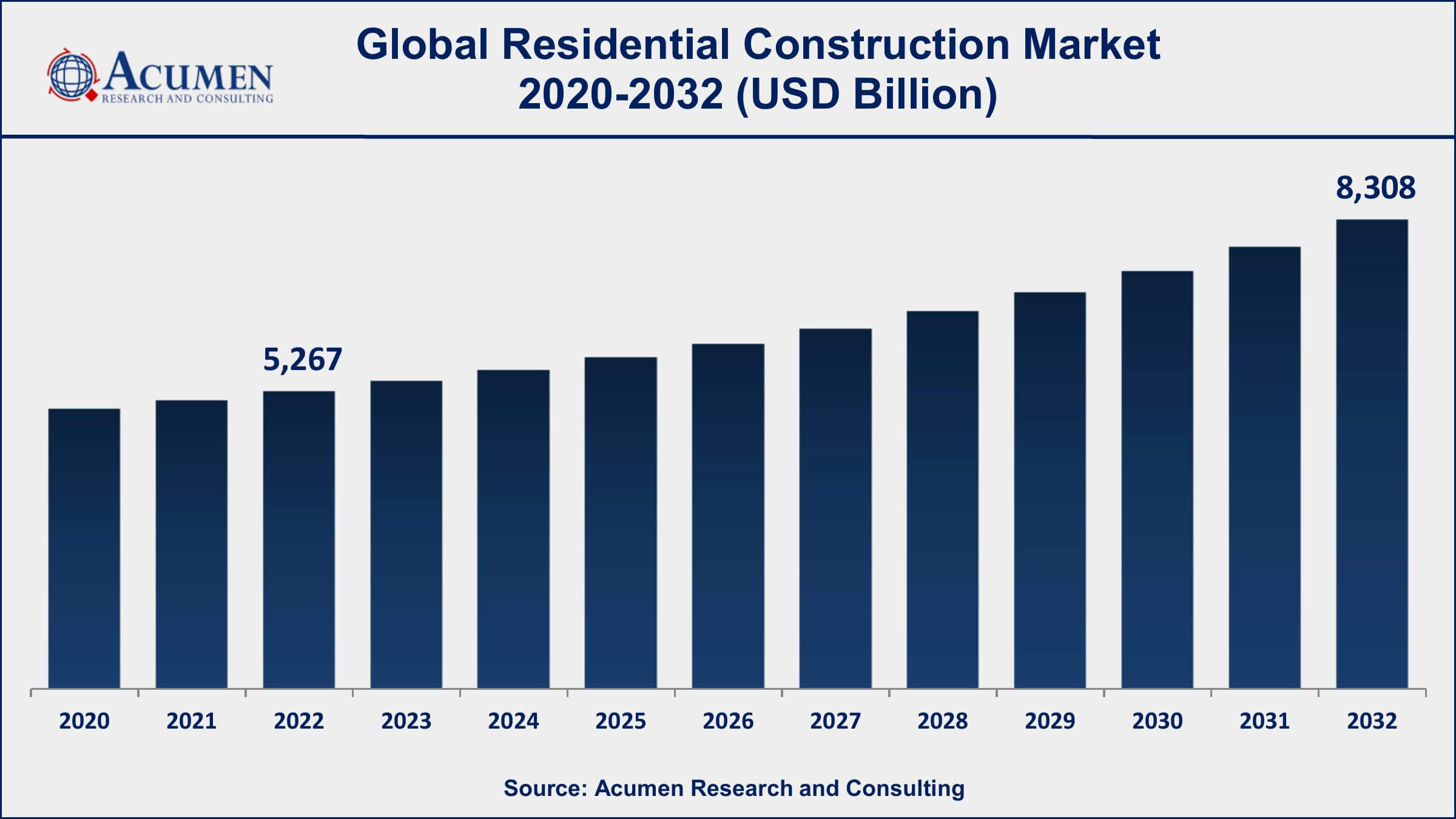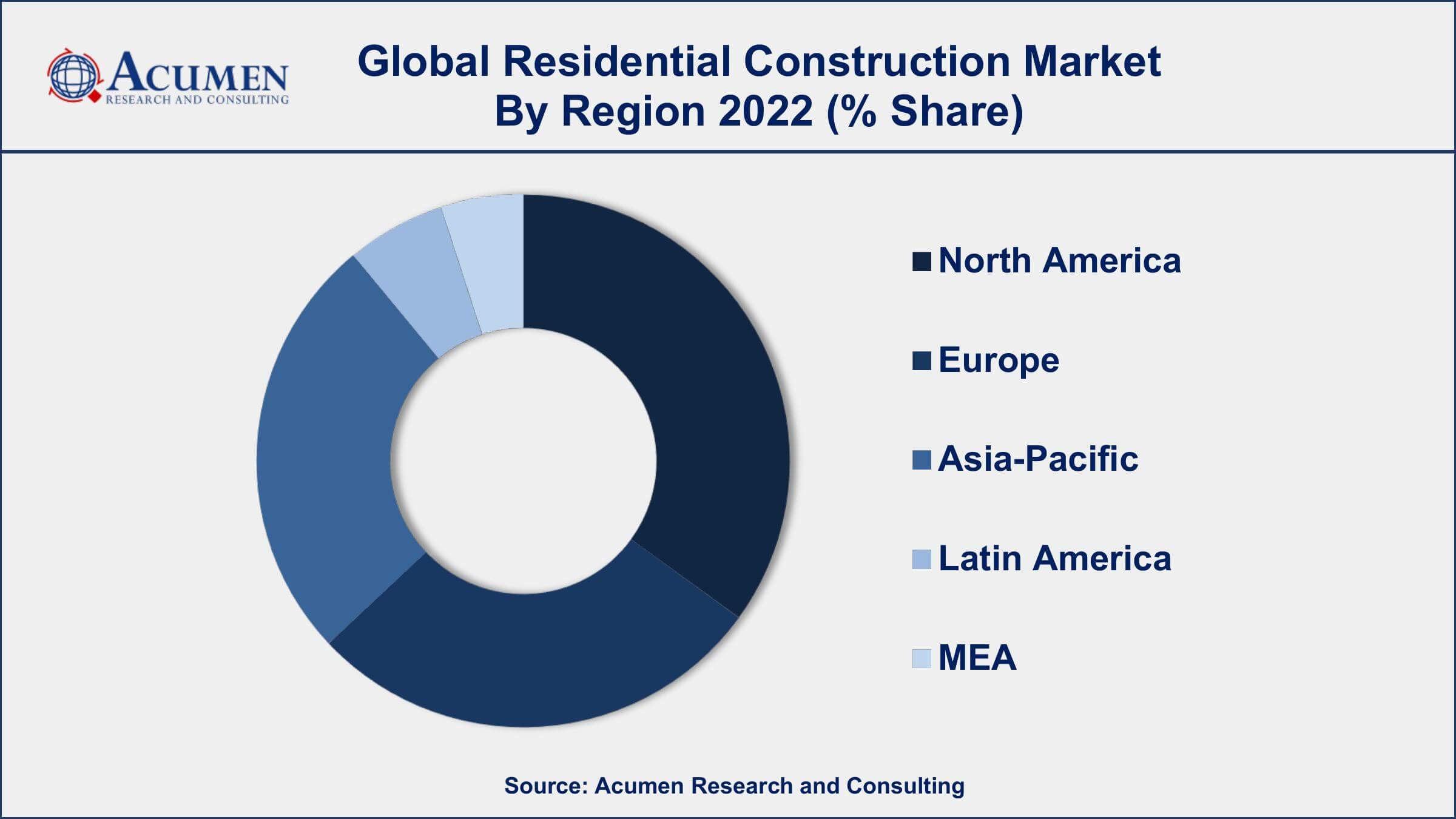March 2024
Residential Construction Market Size accounted for USD 5,267 Billion in 2022 and is projected to achieve a market size of USD 8,308 Billion by 2032 growing at a CAGR of 4.8% from 2023 to 2032.
The Global Residential Construction Market Size accounted for USD 5,267 Billion in 2022 and is projected to achieve a market size of USD 8,308 Billion by 2032 growing at a CAGR of 4.8% from 2023 to 2032.
Residential Construction Market Highlights

Residential construction refers to the process of building or renovating residential structures, including single-family homes, multi-family buildings, and other housing units. It involves various activities such as site preparation, foundation construction, framing, electrical and plumbing installations, interior finishing, and landscaping. Residential construction plays a crucial role in meeting the housing needs of individuals and families, providing them with comfortable and safe living spaces.
The market for residential construction has experienced significant growth over the years, driven by factors such as population growth, urbanization, and economic development. As populations expand and migrate to urban areas, the demand for new housing units rises, leading to increased construction activities. Additionally, factors such as favorable government policies, low-interest rates, and rising disposable incomes have stimulated housing demand and boosted the residential construction market.
In recent years, there has been a growing emphasis on sustainable and energy-efficient construction practices within the residential sector. Green building initiatives and certifications have gained traction, driving the adoption of eco-friendly materials and energy-saving technologies. This focus on sustainability not only benefits the environment but also appeals to environmentally conscious homebuyers. The integration of smart home technologies and modern amenities has also contributed to the market's growth, as consumers increasingly seek innovative and convenient living solutions.

Global Residential Construction Market Trends
Market Drivers
Market Restraints
Market Opportunities
Residential Construction Market Report Coverage
| Market | Residential Construction Market |
| Residential Construction Market Size 2022 | USD 5,267 Billion |
| Residential Construction Market Forecast 2032 | USD 8,308 Billion |
| Residential Construction Market CAGR During 2023 - 2032 | 4.8% |
| Residential Construction Market Analysis Period | 2020 - 2032 |
| Residential Construction Market Base Year | 2022 |
| Residential Construction Market Forecast Data | 2023 - 2032 |
| Segments Covered | By Property Type, By Construction Type, And By Geography |
| Regional Scope | North America, Europe, Asia Pacific, Latin America, and Middle East & Africa |
| Key Companies Profiled | D.R. Horton, Lennar Corporation, PulteGroup, NVR, Inc., Toll Brothers, KB Home, Taylor Morrison Home Corporation, Hovnanian Enterprises, Meritage Homes Corporation, DRB Holdings LLC (Drees Homes), M/I Homes, and Beazer Homes |
| Report Coverage |
Market Trends, Drivers, Restraints, Competitive Analysis, Player Profiling, Covid-19 Analysis, Regulation Analysis |
Residential construction involves various stages, including site preparation, foundation construction, framing, installation of utilities, interior finishing, and landscaping. Residential construction encompasses a range of housing types, from single-family homes to multi-unit buildings such as apartments and condominiums.
The expansion of residential construction is driven by several factors. Population growth, urbanization, and demographic shifts contribute to the increased demand for housing. As more people seek comfortable and functional living spaces, residential construction projects provide the necessary infrastructure to accommodate this demand. Economic factors also play a significant role, with favorable economic conditions and low-interest rates incentivizing individuals and families to invest in homeownership.
Additionally, advancements in technology and construction methods have further facilitated the expansion of residential construction. Innovative building materials, sustainable practices, and smart home technologies are integrated into new construction projects, attracting buyers seeking energy-efficient and technologically advanced homes. Expansion in residential construction also includes the revitalization of older neighborhoods and urban areas, where existing structures are renovated or repurposed to meet modern housing needs.
Residential Construction Market Segmentation
The global residential constructions market segmentation is based on property type, construction type, and geography.
Residential Construction Market By Property Type
In terms of property types, the multi-family segment has seen significant growth in the recent years. This segment refers to the construction of buildings with multiple housing units, such as apartments, condominiums, townhouses, and duplexes. Several factors have contributed to the expansion of the multi-family segment. One key driver of growth is the increasing demand for rental housing. Factors such as changing demographics, lifestyle preferences, and economic conditions have led to a shift towards renting rather than homeownership for many individuals and families. The multi-family segment caters to this demand by providing a wide range of rental options, including affordable housing, luxury apartments, and urban living spaces. Additionally, urbanization and population growth have fueled the growth of the multi-family segment. As more people move to cities and urban areas, the need for high-density housing solutions becomes paramount. Multi-family buildings offer an efficient use of space, allowing for the construction of multiple housing units within a limited footprint. This addresses the demand for housing in densely populated areas and provides convenient living options close to employment centers, amenities, and transportation hubs.
Residential Construction Market By Construction Type
According to the residential construction market forecast, the new construction segment is expected to witness significant growth in the coming years. This segment involves the construction of entirely new residential units, including single-family homes, multi-family buildings, and housing developments. Several factors have contributed to the expansion of the new construction segment. One of the key drivers of growth is population growth and increasing household formation rates. As the population expands, the demand for new housing units rises, leading to increased construction activities. Moreover, as more individuals and families form households, the need for new homes to accommodate these households becomes crucial. Another factor driving the growth of the new construction segment is economic development and rising disposable incomes. Favorable economic conditions, low-interest rates, and improved consumer confidence have stimulated housing demand and encouraged individuals to invest in newly constructed homes. As economic conditions improve, individuals are more inclined to purchase new homes that offer modern features, energy efficiency, and customizable options.
Residential Construction Market Regional Outlook
North America
Europe
Asia-Pacific
Latin America
The Middle East & Africa

Residential Construction Market Regional Analysis
Geographically, North America dominates the residential construction market. One major factor is the robust economic conditions and stable housing market in North America. The region has experienced sustained economic growth, low unemployment rates, and favorable lending conditions, which have stimulated housing demand and encouraged residential construction activities. The availability of accessible financing options and low-interest rates has facilitated homeownership and supported the market growth of the residential construction. Additionally, population growth and urbanization trends in North America have contributed to the dominance of the residential construction industry. The region has witnessed significant population growth, both through natural increase and immigration. This demographic expansion, coupled with the increasing trend of urbanization, has created a strong demand for new housing units. The concentration of population in urban areas has led to the development of multi-family residential projects and the revitalization of urban neighborhoods, further driving the residential construction market.
Residential Construction Market Player
Some of the top Residential Construction Market companies offered in the professional report include D.R. Horton, Lennar Corporation, PulteGroup, NVR, Inc., Toll Brothers, KB Home, Taylor Morrison Home Corporation, Hovnanian Enterprises, Meritage Homes Corporation, DRB Holdings LLC (Drees Homes), M/I Homes, and Beazer Homes.
Looking for discounts, bulk pricing, or custom solutions? Contact us today at sales@acumenresearchandconsulting.com
March 2024
April 2021
October 2024
July 2024